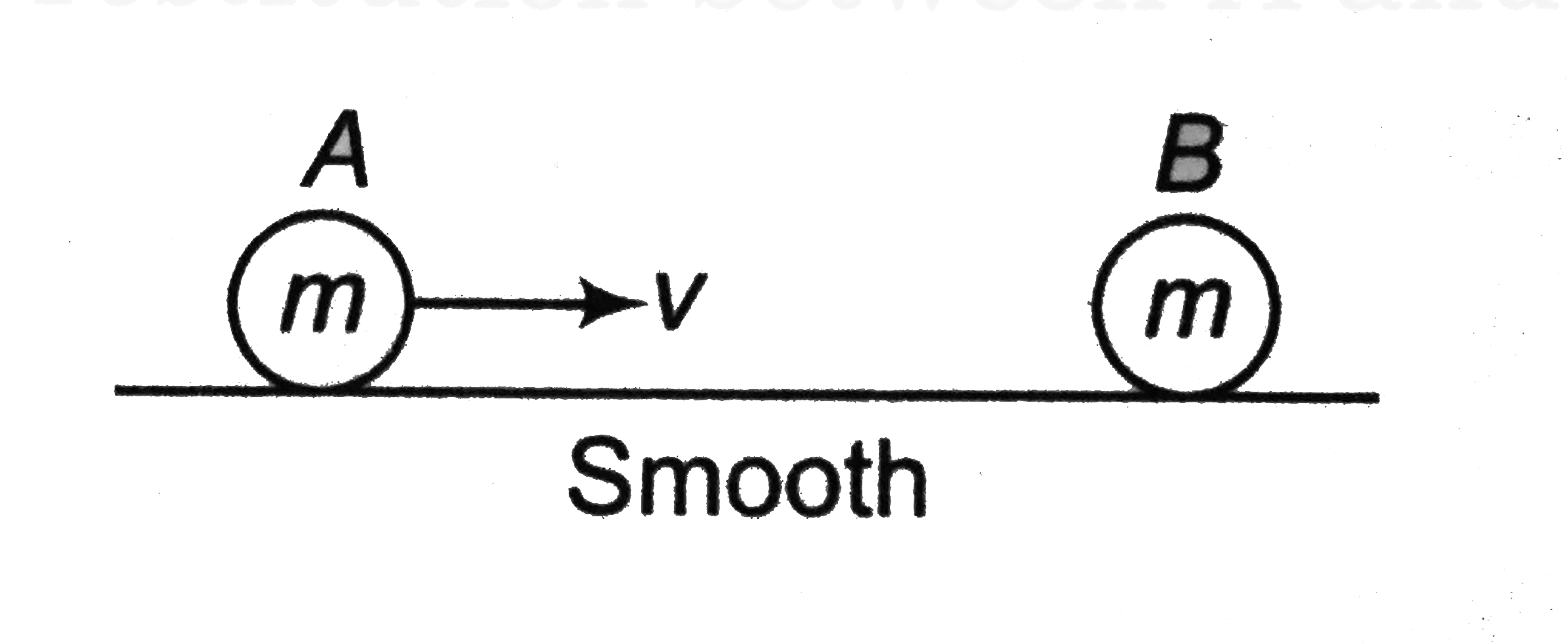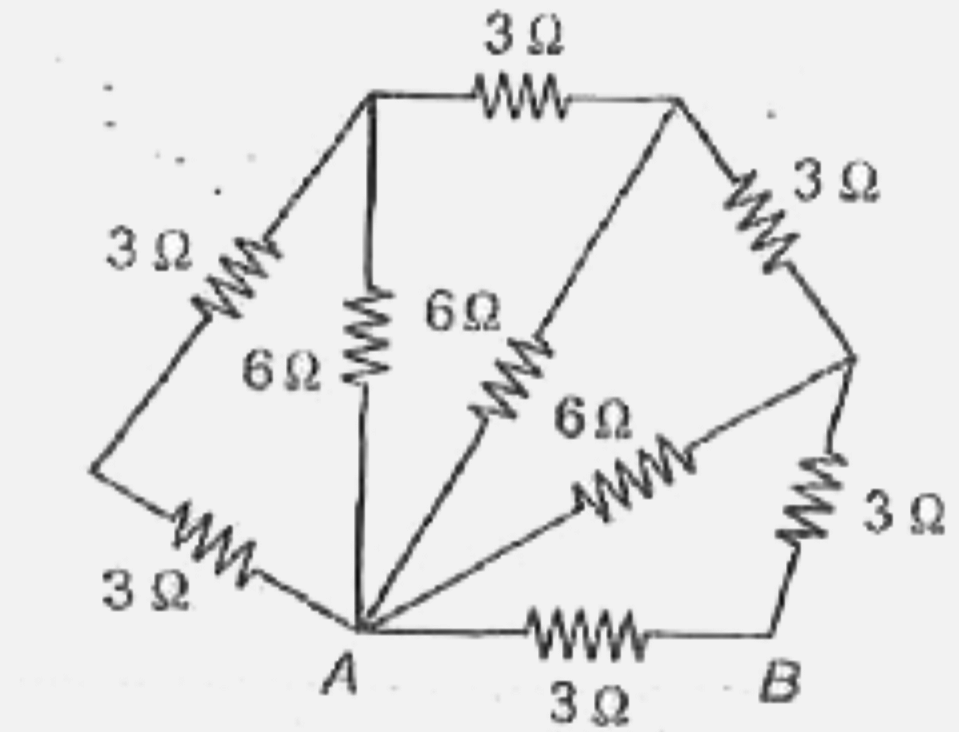In a one-dimensional collision between two identical particles. A and B, B is stationary and A has momentum p before impact. During impact, B gives an impulse J to A. Find the coefficient of restitution between A and B?
The correct Answer is:A, B
To find the coefficient of restitution (e) between two identical particles A and B during a one-dimensional collision where A has momentum p before impact and B is stationary, we can follow these steps:
Step 1: Understand the Initial Conditions
- Particle A has momentum p before the collision.
- Particle B is stationary, so its initial momentum is 0.
Step 2: Define the Impulse Given
- During the collision, B gives an impulse J to A. This means that A's momentum changes due to the impulse received from B.
Step 3: Write the Momentum After Collision
- Let P1 be the momentum of particle A after the collision.
- Let P2 be the momentum of particle B after the collision.
- The impulse J can be expressed in terms of the change in momentum of A:
J=P1−p
Step 4: Apply Conservation of Momentum
- The total momentum before the collision is equal to the total momentum after the collision:
p+0=P1+P2
Therefore,
P1+P2=p
Step 5: Express P2 in Terms of J
- From the impulse equation, we can express P1:
P1=p+J
- Substituting P1 into the momentum conservation equation:
(p+J)+P2=p
This simplifies to:
P2=−J
Step 6: Calculate the Coefficient of Restitution
- The coefficient of restitution e is defined as the ratio of the relative velocity of separation to the relative velocity of approach:
e=VB,after−VA,afterVA,before−VB,before
- Since B is stationary before the collision, its initial velocity is 0, and the initial velocity of A can be expressed as:
VA,before=pm(where m is the mass of A)
- After the collision, the velocities can be expressed as:
VA,after=P1m=p+Jm
VB,after=P2m=−Jm
- Substituting these into the coefficient of restitution formula:
e=(−Jm)−(p+Jm)pm−0
Simplifying gives:
e=−J−p−Jp=−2J−pp=−2Jp−1
Final Result
Thus, the coefficient of restitution e is:
e=−2Jp−1
- Particle A has momentum p before the collision.
- Particle B is stationary, so its initial momentum is 0.
- During the collision, B gives an impulse J to A. This means that A's momentum changes due to the impulse received from B.
- Let P1 be the momentum of particle A after the collision.
- Let P2 be the momentum of particle B after the collision.
- The impulse J can be expressed in terms of the change in momentum of A:
J=P1−p
- The total momentum before the collision is equal to the total momentum after the collision:
p+0=P1+P2
Therefore,
P1+P2=p
- From the impulse equation, we can express P1:
P1=p+J
- Substituting P1 into the momentum conservation equation:
(p+J)+P2=p
This simplifies to:
P2=−J
- The coefficient of restitution e is defined as the ratio of the relative velocity of separation to the relative velocity of approach:
e=VB,after−VA,afterVA,before−VB,before
- Since B is stationary before the collision, its initial velocity is 0, and the initial velocity of A can be expressed as:
VA,before=pm(where m is the mass of A)
- After the collision, the velocities can be expressed as:
VA,after=P1m=p+Jm
VB,after=P2m=−Jm
- Substituting these into the coefficient of restitution formula:
e=(−Jm)−(p+Jm)pm−0
Simplifying gives:
e=−J−p−Jp=−2J−pp=−2Jp−1
Thus, the coefficient of restitution e is:
e=−2Jp−1
Topper's Solved these Questions
- CENTRE OF MASS, LINEAR MOMENTUM AND COLLISIONBOOK - DC PANDEY ENGLISHCHAPTER - CENTRE OF MASS, LINEAR MOMENTUM AND COLLISIONEXERCISE - Level 1 Subjective Questions
1 Videos
- CENTRE OF MASS, LINEAR MOMENTUM AND COLLISIONBOOK - DC PANDEY ENGLISHCHAPTER - CENTRE OF MASS, LINEAR MOMENTUM AND COLLISIONEXERCISE - Level 2 Single Correct
23 Videos
- CENTRE OF MASS, LINEAR MOMENTUM AND COLLISIONBOOK - DC PANDEY ENGLISHCHAPTER - CENTRE OF MASS, LINEAR MOMENTUM AND COLLISIONEXERCISE - Level 1 Objective
42 Videos
- CENTRE OF MASS, IMPULSE AND MOMENTUMBOOK - DC PANDEY ENGLISHCHAPTER - CENTRE OF MASS, IMPULSE AND MOMENTUMEXERCISE - Comprehension type questions
15 Videos
- CIRCULAR MOTIONBOOK - DC PANDEY ENGLISHCHAPTER - CIRCULAR MOTIONEXERCISE - Medical entrances s gallery
19 Videos
Similar Questions
In a one dimensional collision between two identical particles A and B, B is stationary and A has momentum p before impact. During impact, B gives impulse J to A.
View SolutionIn one dimentional collision between two idential particles 'A' and 'B'. 'B' is stationary and 'A' has momentum 54 kg-m/ sec before impact. During impact , 'B' gives an impulse 3kg-m/sec to 'A' . The coefficient of restitution between A and B is
View Solution
Knowledge Check
In an elastic one dimensional collision between two particles the relative veloctiy of approach before collision is
Agreater than the relative velocity of separation after collisionBless than the relative velocity of separation after collisionCequal to the relative velocity of separation after collisionDless than the relative velocity of separation if the incoming particle is heavier than the target particle
In a head on collision between two identical particles A and B moving on a horizontal surface, B is stationary and A has momentum P0 before impact. Due to the impact, A recrieves an impulse I. Then coefficient of restitution between the two is :
View SolutionIn the figure shown, coefficient of restitution between A and B is e=12, then

View SolutionA body X with a momentum p collides with another identical stationary body Y one dimensionally. During the collision, Y gives an impulse J to body X. Then coefficient of restitution is
View SolutionFind the single arithmetic mean between: (a−b)and(a+b)
View SolutionFind the equivalent resistance between A and B in the give figure .

View SolutionA sphere A of mass m, travelling with speed v, collides directly with a stationary sphere B. If A is brought to rest and B is given a speed V, find (a) the mass of B (b) the coefficient of restitution between A and B?
View SolutionTwo billiard balls of same size and mass are in contact on a billiard table. A third ball of same mass and size strikes them symmetrically and remains at rest after the impact. Find the coefficient of restitution between the balls?
View Solution
